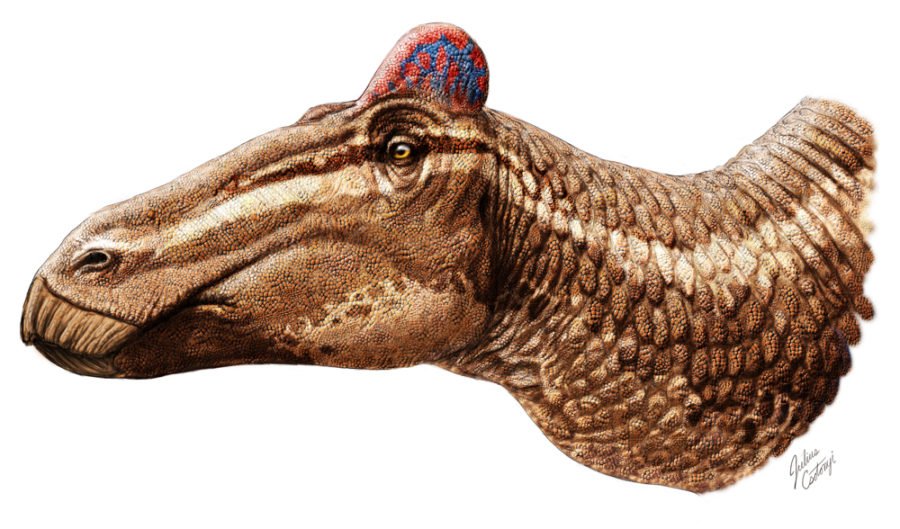Duck-billed dinosaur had strange embellishment

A TEAM OF SCIENTISTS lead by an Australian palaeontologist have discovered something unexpected in a mummified specimen of the duck-billed dinosaur Edmontosaurus regalis.
Most dinosaur fossils only preserve the remains of the skeleton, but in rare cases soft tissues such as skin and feathers are also retained. Now, researchers led by Dr Phil Bell at the University of New England in Armidale, NSW, have for the first time found evidence of a fleshy head-comb on a dinosaur, similar to the kind that roosters have today.
The Edmontosaurus they have been studying is a mummified specimen of the 12m-long species with an unusually fine level of preservation; the 70-million-year-old fossil was found in west-Central Alberta, Canada, in 2011 and is being held at the University of Alberta in Edmonton, Alberta.
The discovery was detailed today in the journal Current Biology.
Dinosaur display feature
“It changes our perception of the appearance of these animals, and suggests new knowledge about their evolution and behaviour,” Phil told Australian Geographic. “These features could be present in other dinosaurs – it seems very likely to me. We’ve only had bones [of head crests] to go by until now.”
“It’s quite an exciting find, because until now we haven’t had hard evidence of any fleshy structures on dinosaurs,” agrees Professor John Long, a palaeontologist at Flinders University in Adelaide who was not involved in the research. “It opens up a whole world of imaginative ways for us to think about what these wonderful animals could have actually looked like.”
The skull itself has no indication of the presence of a crest, which is not surprising, say the experts. “If you look at the skull of a rhino, you don’t see the horns. It is the same with most of the soft tissue structures in animals today,” John says.
Soft tissue is rarely fossilised, but is sometimes preserved when the conditions are right. Even in cases when there is some evidence of it – such as skin impressions – in the past palaeontologists have either missed the clues or ignored them.
However, following the discovery of a large number of feathered dinosaurs in China starting in the late 1990s, with an unusual level of preservation, researchers elsewhere have been searching much more carefully for soft tissue clues.
Function of the fleshy crest
As to the function of the fleshy crest, Phil thinks that it was probably a means of signalling health and status – and displaying to potential mates and adversaries – much as rooster combs today are used.
“In other dinosaurs we have found bone crests, connected to the nasal cavity which helped resonate sound to make their bellows louder. This fleshy crest was not attached to the nose at all, and it was too small to store anything, so it had to be a visual thing,” he adds.
“This is equivalent to discovering for the first time that elephants had trunks. We have lots of skulls of Edmontosaurus, but there are no clues on them that suggest they might have had a big fleshy crest. There’s no reason that other strange fleshy structures couldn’t have been present on a whole range of other dinosaurs, including T. rex or Triceratops.”
Duck-billed species such as Edmontosaurus were the most common kinds of dinosaur in North America 70 million years ago. They get their name from the snout, which is broad and flattened like a duck’s beak, useful for munching on plants, and they lived in great herds that roamed coastal plains and river deltas.

